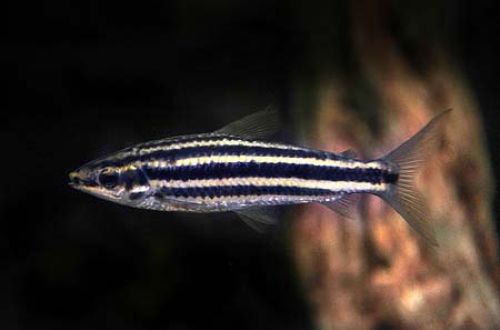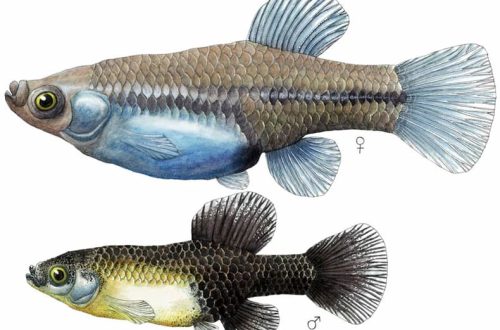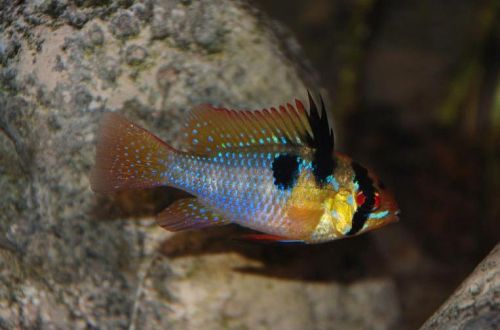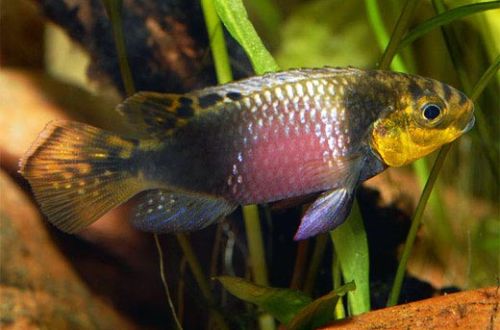
Pelvicachromis cribensis
Pelvicachromis cribensis or Kribensis net, scientific name Pelvicachromis subocellatus, belongs to the Cichlidae family. Sometimes referred to as “Reticulated Parrot”. It is easy to keep and breed, can successfully adapt to various conditions, which, along with a peaceful disposition, allows you to keep this species with many popular aquarium fish. May be recommended for beginner aquarists.

Contents
Habitat
Occurs from the western part of equatorial Africa from the territory of modern Nigeria, Gabon and the Democratic Republic of the Congo. It is found in coastal areas where rivers flow into the ocean, often inhabiting brackish waters.
Brief information:
- The volume of the aquarium – from 70 liters.
- Temperature – 22-26°C
- Value pH — 5.5–8.0
- Water hardness – soft to hard (5-20 dGH)
- Substrate type – sandy or fine gravel
- Lighting – subdued
- Brackish water – yes, the permissible concentration is up to 10 g. of salt per liter
- Water movement is weak
- The size of the fish is about 8 cm.
- Meals – any
- Temperament – peaceful
- Content both individually and in a group
Description
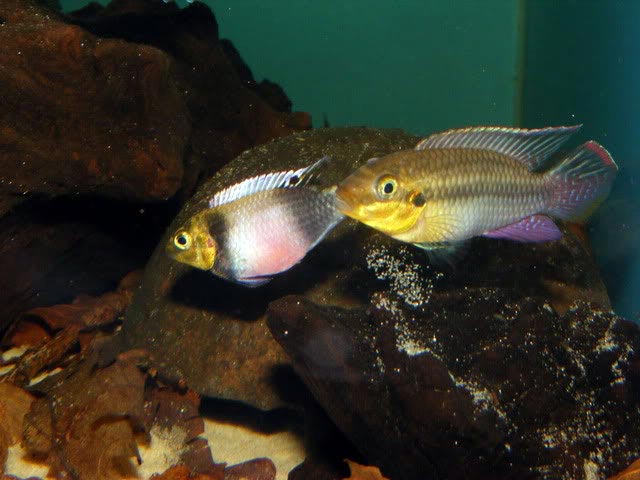
Adults reach a length of about 8 cm. Males are larger and have more elongated and pointed dorsal and anal fins compared to females, the body color is gray with a dark horizontal stripe, the head is painted yellow, the anal fin and tail have a pinkish tint. Females look a little different, the body is painted alternately in black and white, and during the mating season, the white color changes to pink, which symbolizes the beginning of spawning.
Food
Accepts most types of dry food, which should contain a large amount of protein. It is advisable to include in the diet also live or frozen food from bloodworms, brine shrimp, daphnia, etc.
Maintenance and care, arrangement of the aquarium
The optimal size of the aquarium for a pair of adult fish starts from 70 liters. The design is arbitrary, provided that there is a sufficient number of shelters – these can be snags, decorative objects imitating grottoes, crevices, caves, or ordinary ceramic pots turned over on their side. Sand or fine gravel is used as a substrate, the presence of plants is not necessary.
The filtration system is adjusted in such a way as not to create excessive internal flow, since Kribensis mesh does not tolerate water movement.
Aquatic conditions have a wide acceptable range of pH and dGH values. Possible content in brackish water at a salt concentration of up to 10 g. per 1 liter.
Behavior and Compatibility
Peace-loving calm species, even during the spawning period, when males defend their territory, they will not cause big problems to other neighbors. Pairs well with most fish species of similar size and temperament. In a small aquarium, it is desirable to keep only one pair of Cribensis in order to avoid competition with relatives for territory.
Breeding / breeding
Fish form a monogamous pair, which can persist throughout their lives. It is worth noting that Pelvicachromis cribensis is careful in choosing a partner. If you add an adult male and female to the aquarium, then there is no guarantee that they will be able to form a pair. Therefore, if you plan to start breeding, then you can choose one of two methods. The first is to acquire a dozen young fish, among which, as they grow older, at least one pair will almost certainly appear. The second is to buy an already formed pair.
Otherwise, the process of breeding Kribensis reticulata is quite simple. The stimulus for the beginning of the mating season is a gradual change in water conditions to the following values: pH 5.5–6.5, dGH 5–10, temperature 23–26°C. You can determine that the fish are ready for spawning by the females, at this time their abdomen turns pink. Having decided on a place, usually it is a small cave, the female retires in it for several days and lays up to 200 eggs. The male stays outside and guards the approaches to the spawning ground.
The incubation period lasts 2-3 days, after another week the fry begin to swim freely, however, they do not swim far from their parents. The female, together with the male, continues to protect her offspring.
Fish diseases
The main cause of most diseases is unsuitable living conditions and poor-quality food. If the first symptoms are detected, you should check the water parameters and the presence of high concentrations of hazardous substances (ammonia, nitrites, nitrates, etc.), if necessary, bring the indicators back to normal and only then proceed with treatment. Read more about symptoms and treatments in the Aquarium Fish Diseases section.



